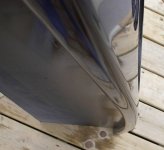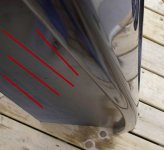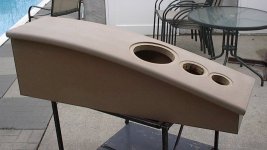because i was doing shelvs and the sides are thin spray was not really working but was perfect for the bigger flat parts. more the edge but i guess i could paint then sand then after that spray should work for the smoothness.
i sure i brush was crap and out side was bad idea tho bits floating on it
thanks i will have a look into them brushes never heard of it
the roller way was not to bad but leaves a different pattern not tried the gloss roller bit tho
thanks
i sure i brush was crap and out side was bad idea tho bits floating on it
thanks i will have a look into them brushes never heard of it
the roller way was not to bad but leaves a different pattern not tried the gloss roller bit tho
thanks
ShinOBIWAN said:That just it though, it could be any of the two most plausable explanations:
1. The entire end grain is expanding leaving a depression on the joint because the glue doesn't follow suit.
2. The end grain is relatively stable and the PVA is shrinking/moving revealing the joints.
I'm betting on #2 because if you do a butt joint, one part is end grain but the other part is not. But still it's the whole width of the glue line that shows rather than a smaller line at one side of the glue line.
richie00boy said:
I'm betting on #2 because if you do a butt joint, one part is end grain but the other part is not. But still it's the whole width of the glue line that shows rather than a smaller line at one side of the glue line.
For me, the end grain raises above the face hence my inclination towards no 1. Running my hand over the tweeter cabinet on the LGT's confirms this.
But I can also see the glue line in the joint has depressed compared to the face. So could be both unless the MDF face has expanded but at a lesser rate than the end grain causing the dip on the joint.
😕

larksp said:a noob question
when painting gloss or primer by paintbrush is the a way to get way less brush marks......
mine often looks like a sand storm has hit it.
i had done wet sand to 1200 and washed it soapy water
Washed? Water??
Nooooo... not on MDF!!
That will effectively undo your 1200grit sanding.
Damp wipe at most.
The 1200 grit sanding should come AFTER an initial coating of whatever you are using.
Ok, so maybe you were sanding 1200 after coating... i dunno.
In which case some polishing will bring back gloss, if you are looking for that... for no brush marks - spray.
But, to make paint go smoother, buy a commercial paint aditive that is intended to improve "flow"... 😀
_-_-bear
The foam rollers are great, but can take some practice to get smooth.
I use to roll coat fine art prints by hand with acrylic glaze and a small foam roller. It does take practice to get a smooth finish with no lines or bubbles. A light touch helps a lot.
Every surface and paint or medium will be different, so practice with what you will be using. It can be done and look very nice. But the first few won't. =)
I use to roll coat fine art prints by hand with acrylic glaze and a small foam roller. It does take practice to get a smooth finish with no lines or bubbles. A light touch helps a lot.
Every surface and paint or medium will be different, so practice with what you will be using. It can be done and look very nice. But the first few won't. =)
richie00boy said:LOL that could be quite funny. I'll have to sort out coming soon though, which could be a bit difficult.
Yea, I had visions of someone intercepting it and trying to do a couple of lines. That'd give 'em a surprise 😀
No worries on visiting - just give me notice when it's OK.
ShinOBIWAN said:For me, the end grain raises above the face hence my inclination towards no 1. Running my hand over the tweeter cabinet on the LGT's confirms this.
But I can also see the glue line in the joint has depressed compared to the face. So could be both unless the MDF face has expanded but at a lesser rate than the end grain causing the dip on the joint.
Some good points there. I've only done a few cabs with butt or rebate joints, and come to think of it, you're probably right about the slight raising of the cut end grain. However, the sinking glue line is always far more severe for me.
I've had a response from West, and they confirm that the epoxy should completely seal what's being covered (from both air and moisture).
Interestingly, they did indicate that more coats (applied with a roller) may be needed to get a good seal - especially considering I'm flatting the cured epoxy. The first test piece (and something I'm working on right now) had coats applied with a brush, and hence got a much thicker covering.
It'll be a while before the current piece gets painted, but I'll report on the results.
Yea... it's worth a try I guess (getting it through the postal system).
Think in terms of covering a 5x5" area; i.e. 25sq inches. That'll be plenty for me to glue up one of my test blocks.
I'll email you with an address, cheers.
Think in terms of covering a 5x5" area; i.e. 25sq inches. That'll be plenty for me to glue up one of my test blocks.
I'll email you with an address, cheers.
A quick update on the glue/MDF/movement issue...
My local area (Oxfordshire) has an annual event in which local artists and businesses open their premises up to the public (artweeks). It's well worth your time BTW.
I was chatting to a guy at a bespoke furniture manufacturer, and he noted they sometimes use MDF as a core (with veneer) specifically because it doesn't 'move'. He was talking about it in relation to veneering over real wood though.
On the subject of glues, he did think there might be something in the PVA issue. They use Extramite to attach veneers to MDF, because it dries hard and brittle, as oppsed to PVA which dries slightly rubbery.
I mentioned it was for loudspeakers, and he wondered if a brittle glue might have problems with a speaker cabinet under pressure, but I don't think that would be a big problem.
Anyway, nothing conclusive, but certainly a few more gentle prods in the direction of harder drying glues...
My local area (Oxfordshire) has an annual event in which local artists and businesses open their premises up to the public (artweeks). It's well worth your time BTW.
I was chatting to a guy at a bespoke furniture manufacturer, and he noted they sometimes use MDF as a core (with veneer) specifically because it doesn't 'move'. He was talking about it in relation to veneering over real wood though.
On the subject of glues, he did think there might be something in the PVA issue. They use Extramite to attach veneers to MDF, because it dries hard and brittle, as oppsed to PVA which dries slightly rubbery.
I mentioned it was for loudspeakers, and he wondered if a brittle glue might have problems with a speaker cabinet under pressure, but I don't think that would be a big problem.
Anyway, nothing conclusive, but certainly a few more gentle prods in the direction of harder drying glues...
Hi Spoo,
PVA glue for MDF is as strong as needed. I use yellow carpenters glue, which is stronger than the white variety. Apply a generous amount, then clamp tight.
Not enough glue in the joint might be the cause of your lines, it could also be that the pieces weren't clamped tight enough.
The biggest problem with priming MDF is the end grain. Everyone knows that it absorbs quicker than the face grain, but the real problem is that it can suck the solvents and/or resins out of the paint and leaving an inferior finish. It will literally seperate the paint as it's being applied.
Treating the edge grain with a urethane based finish prior to priming will block this absorpsion problem.
In the pic below is a speaker baffle that is laminated with 2 layers of 5/8" MDF. The first layer was glued, clamped and screwed to the box. the second layer was just glued and clamped - no screws. As can be seen, there is quite a curve to it (about 5" out of line). It took considerable clamp pressure to curve the MDF, and the only thing holding it on is yellow carpenters glue.
It's strong enough.
PVA glue for MDF is as strong as needed. I use yellow carpenters glue, which is stronger than the white variety. Apply a generous amount, then clamp tight.
Not enough glue in the joint might be the cause of your lines, it could also be that the pieces weren't clamped tight enough.
The biggest problem with priming MDF is the end grain. Everyone knows that it absorbs quicker than the face grain, but the real problem is that it can suck the solvents and/or resins out of the paint and leaving an inferior finish. It will literally seperate the paint as it's being applied.
Treating the edge grain with a urethane based finish prior to priming will block this absorpsion problem.
In the pic below is a speaker baffle that is laminated with 2 layers of 5/8" MDF. The first layer was glued, clamped and screwed to the box. the second layer was just glued and clamped - no screws. As can be seen, there is quite a curve to it (about 5" out of line). It took considerable clamp pressure to curve the MDF, and the only thing holding it on is yellow carpenters glue.
It's strong enough.
Attachments
Interesting information sploo. All I can say is that Extramite although more brittle than PVA seems to be fine for speaker cabinets and many other things in my experience.
I suppose a test could be to make up a rough small box then lob it about and see if you can crack the joints.
I suppose a test could be to make up a rough small box then lob it about and see if you can crack the joints.
Maybe more of an issue with a small sealed sub using a high excursion driver and a Kw of power 😀
TBH I think severe shock would be needed to break the joint, and a sub is never going to have the rise time to do that.
Was more of a geeky joke Rich. I don't think the glue would be an issue at all in any speaker related application.
MJL21193 said:...PVA glue for MDF is as strong as needed...
Hi John, I was hoping you'd reply to this thread.
I've been effectively 'painting' on glue before clamping together, so I was hoping that would be enough.
I must admit I saw a professional company laminating sections of plywood (to then slice as kitchen table tops) and the glue was pretty much spraying out the sides... I don't use that much.
What urethane products are you using? I'll see if I can get them here in the UK.
Love the curved baffle - but I notice what looks like lines in the finish down the left hand side of the image. They appear quite similar to the problems I've been seeing. Are they an artifact of the camera/reflection of something else/a different problem?
ShinOBIWAN said:Was more of a geeky joke Rich. I don't think the glue would be an issue at all in any speaker related application.
This reminded me of speaking recently to a mate of mine who's in a band - I was wondering about having a summer+gig party in my garden, and asked him what amplifier gear they'd need. "9kW PA!" was the response 😉
Wonder how those speakers are glued together!
I'm pretty sure its floor reflections since they're regularly spaced and I can't think how or why you'd have joints in those positions.
Hi,sploo said:
What urethane products are you using? I'll see if I can get them here in the UK.
Love the curved baffle - but I notice what looks like lines in the finish down the left hand side of the image. They appear quite similar to the problems I've been seeing. Are they an artifact of the camera/reflection of something else/a different problem?
Paint (or any urethane based paint):
http://www.overflex.com/product.asp?frm_product_id=617&SBL=5
Use non-water based polyurethane(clear) to seal the edge if the finish is going to be different (not urethane based). Urethane doesn't seperate easily, so it will seal the edge grain completely. Let dry at least a day, then sand smooth. Urethane is highly resistant to other solvents when dry.
Part of my sucess with this problem is the products I use. When built up thick it seems to have some flexibility. It's not as hard and brittle as some finishes. I've also used Tremco Rust Enamel and Sherwin Williams All Surface Enamel Alkyd - all fairly cheap stuff. The only drawback is how long it takes for the paint to cure.
The area you pointed to is the side of the box, and is un-finished (just hit by overspray). It will be given a layer of cherry veneer plywood. Only the curved front baffle is finish painted. As I mentioned before it's two layers of MDF glued together. No line is visable at the joint, in fact it appears to be a single solid thick piece. The picture is a few hours after painting (10 coats).
Here it is before primer:
Attachments
Nice work John. The pictures you've posted previously didn't really show things very clearly but that last one does.
Did you steam the baffle or glue whilst in a press to get the curve?
Did you steam the baffle or glue whilst in a press to get the curve?
- Status
- Not open for further replies.
- Home
- Loudspeakers
- Multi-Way
- Priming MDF boxes


